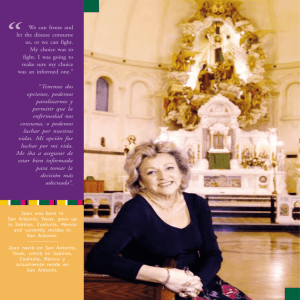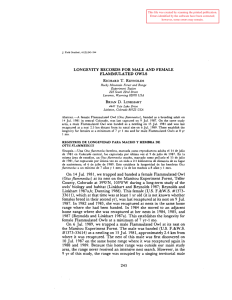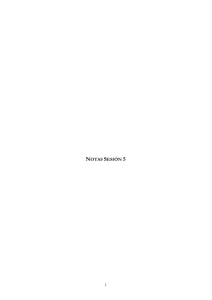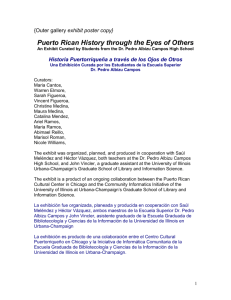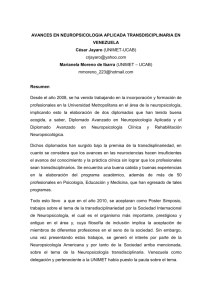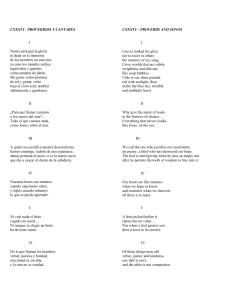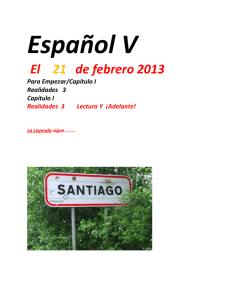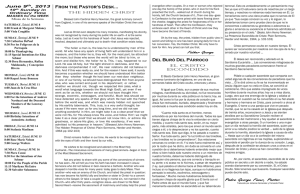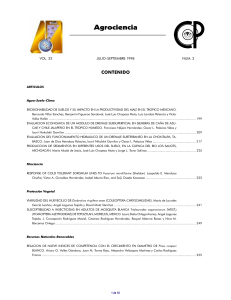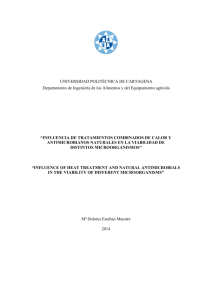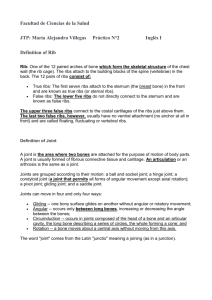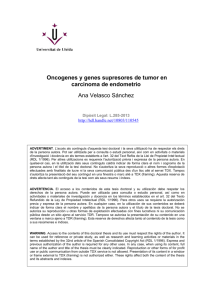PRÁCTICA V.8 NUEVA Y CONVENIENTE SÍNTESIS DE
advertisement
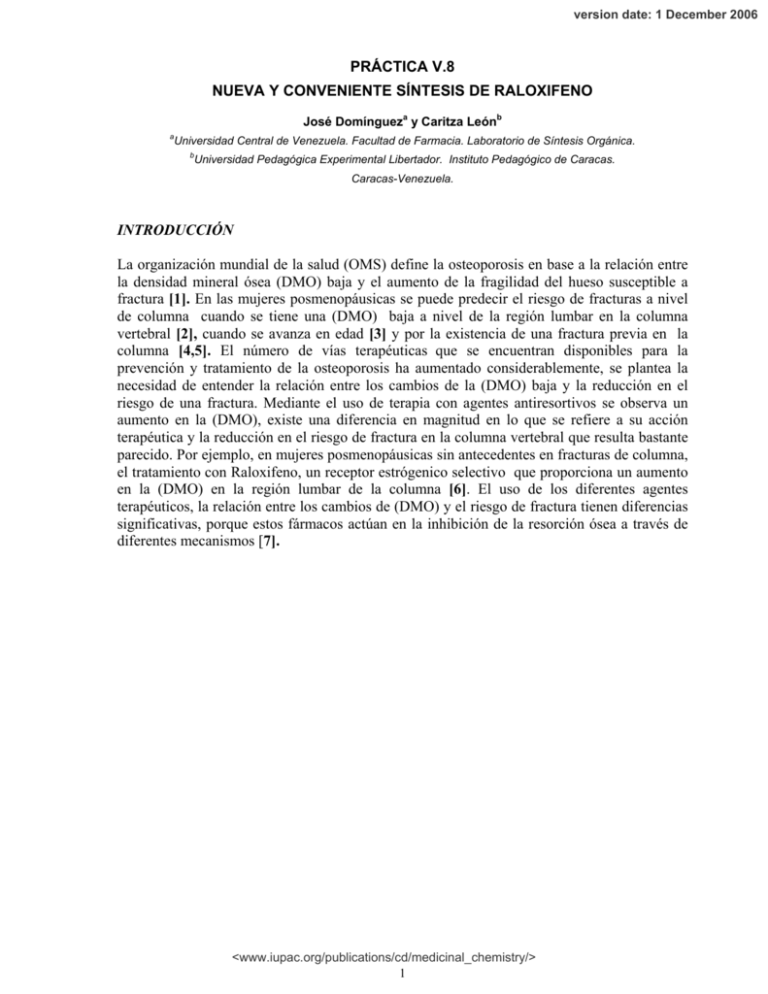
version date: 1 December 2006 PRÁCTICA V.8 NUEVA Y CONVENIENTE SÍNTESIS DE RALOXIFENO José Domíngueza y Caritza Leónb a Universidad Central de Venezuela. Facultad de Farmacia. Laboratorio de Síntesis Orgánica. b Universidad Pedagógica Experimental Libertador. Instituto Pedagógico de Caracas. Caracas-Venezuela. INTRODUCCIÓN La organización mundial de la salud (OMS) define la osteoporosis en base a la relación entre la densidad mineral ósea (DMO) baja y el aumento de la fragilidad del hueso susceptible a fractura [1]. En las mujeres posmenopáusicas se puede predecir el riesgo de fracturas a nivel de columna cuando se tiene una (DMO) baja a nivel de la región lumbar en la columna vertebral [2], cuando se avanza en edad [3] y por la existencia de una fractura previa en la columna [4,5]. El número de vías terapéuticas que se encuentran disponibles para la prevención y tratamiento de la osteoporosis ha aumentado considerablemente, se plantea la necesidad de entender la relación entre los cambios de la (DMO) baja y la reducción en el riesgo de una fractura. Mediante el uso de terapia con agentes antiresortivos se observa un aumento en la (DMO), existe una diferencia en magnitud en lo que se refiere a su acción terapéutica y la reducción en el riesgo de fractura en la columna vertebral que resulta bastante parecido. Por ejemplo, en mujeres posmenopáusicas sin antecedentes en fracturas de columna, el tratamiento con Raloxifeno, un receptor estrógenico selectivo que proporciona un aumento en la (DMO) en la región lumbar de la columna [6]. El uso de los diferentes agentes terapéuticos, la relación entre los cambios de (DMO) y el riesgo de fractura tienen diferencias significativas, porque estos fármacos actúan en la inhibición de la resorción ósea a través de diferentes mecanismos [7]. <www.iupac.org/publications/cd/medicinal_chemistry/> 1 version date: 1 December 2006 O O HS OR1 R1O Br S i + R2 R2 1 2 3 ii R2 O HCl . R1O R3 N S + O 5 4 iii iv-vi OH O OCH 3 HO + .HCl N HO S O Cl N . HCl O 6 i: KOH, EtOH, 0–50 ºC; ii: 85–90 ºC, H3PO4; iii: BCl3, CH2Cl2, 35 ºC. iv: K2CO3, DMF, 80 ºC; v: NaOH 5 N, MeOH; vi: HCl(c). R1: -CH3; R2: -OCH3; R3: -OH PARTE EXPERIMENTAL[8] Síntesis de α (3-metoxifeniltio)-4-metoxiacetofenona (3) Disolver 100 g de 3-metoxibencenotiol (1) y 39.1 g de hidróxido de potasio en 300 mL de agua y agregar 750 mL de etanol. Colocar el balón en un baño de hielo y añadir lentamente 164 g de α-bromo-4-metoxiacetofenona (2), agitar la mezcla por 10 minutos; agitar la mezcla a temperatura ambiente por 3 horas. Finalizada la reacción, evaporar el solvente bajo presión reducida y añadir 200 mL de agua. Agregar acetato de etilo, transferir a un embudo de separación y extraer varias veces. Lavar la capa orgánica con agua, solución acuosa de NaHCO3 y finalmente con solución saturada de NaCl. Secar la capa orgánica con MgSO4, filtrar y evaporar el solvente a presión reducida. Recristalizar el sólido con metanol. 158 g; Pto. Fusión 53 ºC. Síntesis del Clorhidrato del Ácido 4[2-(1-piperidinil) etoxi]benzoico (4) Mezclar 8.31 g de 4-hidroxibenzoato de metilo, 10.13 g de monoclorhidrato de 1(2cloroetil)piperidina, 16.59 g de K2CO3 y 60 mL de DMF, calentar a 80 ºC. Después de una hora, enfriar la mezcla a 55 ºC, tratar con una porción adicional de monoclorhidrato de 1(2cloroetil)piperidina 0.92 g. Calentar la mezcla a 80 ºC, se controla la reacción por TLC. <www.iupac.org/publications/cd/medicinal_chemistry/> 2 version date: 1 December 2006 Añadir porciones adicionales de clorhidrato de 1(2-cloroetil)piperidina hasta que se consuma el material de partida, una vez finalizada la reacción, se trata la mezcla con 60 mL de agua, se enfría a temperatura ambiente, se extrae con solvente orgánico y después de trabajar de la manera usual se obtuvo un aceite que se usó en la siguiente reacción sin purificación adicional. En la siguiente reacción, 13.87 g del 4(2-piperidinoetoxi)benzoato de metilo obtenido fueron disueltos en 30 mL de metanol con 15 mL de hidróxido de sodio 5 N la mezcla de la reacción se calentó a 40 ºC. Después de 1 ½ horas, se añadió 40 mL de agua y la mezcla resultante se enfrió a 5–10 ºC. Luego se adicionó lentamente 18 mL de ácido clorhídrico concentrado, se obtuvo un producto cristalino, se filtró y se secó al vacío a 4050 ºC. 12.49 g (83 %); Pto. Fusión 270–271 ºC. Síntesis de 6-metoxi-2-(4-metoxifenil)benzo[b]tiofeno (5) Agregar en pequeñas porciones 12.4 g del intermediario (3) en 93.0 g de ácido polifosfórico a 85 ºC. Tenga precaución; durante la adición la temperatura puede aumentar a 95 ºC. Finalizada la adición del ácido, se agitó durante 30 min a 90 ºC. Después de 45 min adicionales, se dejó enfriar la mezcla de reacción a temperatura ambiente. La mezcla de reacción se enfrió en un baño de hielo. Se agregó 10 mL de agua, se filtró al vacío y el sólido obtenido se lavó con agua y metanol, se secó al vacío a 40 ºC para dar 11.9 g del crudo, el cual fue suspendido en metanol caliente, se filtró y se lavó con metanol frío. El sólido obtenido se recristalizó en acetato de etilo, se filtró, se lavó con hexano y se secó al vacío. 6.8 g; Pto. Fusión 187–191 ºC. Síntesis de clorhidrato de 6-hidroxi-2(4-hidroxifenil)-3[4-(2-piperidinoetoxi) benzoil]benzo[b]tiofeno (6) A una mezcla en frío de 2.92 g del compuesto (5) y 3.45 g del compuesto (4) disueltos en diclorometano 52 mL, se añadió BCl3 gaseoso 2.8 mL(condensado previamente en un cilindro graduado), después de 8 horas a 0 ºC, se agregó BCl3 2.8 mL. La solución resultante se calentó a 35 ºC. Una vez finalizada la reacción (16 horas) se trató la mezcla con 30 mL de metanol por un tiempo de 20 min, provocando que el metanol llegara a reflujo. Se agitó la suspensión resultante a temperatura ambiente y después de 1 hora, se filtró el producto, se lavó con metanol frío 8 mL y se secó a 40 ºC al vacío. 5.14 g; Pto. Fusión 225 ºC. Para la siguiente reacción, una solución de NaOH (0.313 g) en metanol (10 mL) se diluyó con 50 mL adicionales de metanol y se añadió 4.0 g del producto anteriormente obtenido. Después de 45 minutos a temperatura ambiente, se filtró la solución y el filtrado se trató con de HCl 2 N 4 mL, se obtuvo una suspensión cristalina. Después de 1 1/2 horas, se filtró, se lavó con metanol 5 mL y se secó al vacío a 45–50 ºC. 2.10 g; Pto. Fusión 261 ºC. REFERENCIAS [1]. Genant HK, Cooper C, Poor G, Reid I, Ehrlich G, Kanis J, Nordin BEC, Barrett-Connor E, Black D, Bonjour JP, Dawson-Hughes B, Delmas PD, Dequeker J, Ragi Eis S, Gennari C, Johnell O, Johnston CC, Lau EMC, Liberman UA, Lindsay R, Martin TJ, Masri B, Mautalen C, Meunier PJ, Miller PD, Mithal A, Morii H, Papapoulos S, Woolf A, Yu W, Khaltaev N 2000 Interim report and recommendations of the World Health Organization Task-Force for Osteoporosis. Osteoporos.Int 10:259-264. [2]. Melton LJ III, Atkinson EJ, O'Fallon WM, Wahner HW, Riggs BL 1993 Long-term fracture prediction by bone mineral assessed at different skeletal sites. J. Bone. Miner. Res. 8:1227-1233. <www.iupac.org/publications/cd/medicinal_chemistry/> 3 version date: 1 December 2006 [3]. Melton LJ III, Atkinson EJ, Khosla S, O'Fallon WM, Riggs BL 1999 Secondary osteoporosis and the risk of vertebral deformities in women. Bone 24:49-55 [4]. Ross PD, Davis JW, Epstein RS, Wasnich RD 1991 Pre-existing fractures and bone mass predict vertebral fracture incidence in women. Ann. Intern. Med. 114:919-923. [5]. Lindsay R, Silverman SL, Cooper C, Hanley DA, Barton I, Broy SB, Licata A, Benhamou L, Geusens P, Flowers K, Stracke H, Seeman E 2001 Risk of new vertebral fracture in the year following a fracture. J.Amer.Med.Assoc. 285:320-323. [6]. Ettinger B, Black DM, Mitlak BH, Knickerbocker RK, Nickelsen T, Genant HK, Christiansen C, Delmas PD, Zanchetta JR, Stakkestad J, Gluer CC, Krueger K, Cohen FJ, Eckert S, Ensrud K, Avioli LV, Lips P, Cummings SR 1999 Reduction of vertebral fracture risk in postmenopausal women with osteoporosis treated with raloxifene: Results from a 3year randomized clinical trial. J.Amer.Med.Assoc. 282:637-645. [7].Eastell R 1998 Treatment of postmenopausal osteoporosis. N.Engl.J.Med. 338:736-746. [8]. E.S.Labell (Eli Lilly). 1.994. Patent # WO9609045. José Domíngueza & Caritza Leónb dominguj@camelot.rect.ucv.ve El trabajo en los laboratorios de Medicinal Chemistry debe mantener altos estándares de precaución y buen uso. El manejo de instrumental eléctrico, la utilización del calor, el material de cristal y los disolventes no presentan un especial problema, si se siguen las instrucciones del supervisor. Estabilidad: Gas inestable e incoloro (boron trichloride). Altamente inflamable; incompatible con metales; reacciona violentamente con agua y fuertemente con “aniline, phosphine, dinitrogen tetroxide”. Produce vapores en presencia de aire húmedo. <www.iupac.org/publications/cd/medicinal_chemistry/> 4 version date: 1 December 2006 Toxicología: Muy tóxico si se inhala o se ingiere. Corrosivo. Causa quemaduras. Puede dañar y destruir las membranas mucosas. Protección personal: Es recomendable llevar ropa protecctora adecuada, gafas de seguridad y guantes. Mantener el recipiente en un lugar con buena ventilación. En caso de que entre en contacto con los ojos, lavar inmediatamente con abundante agua y pida consejo médico. Si entrase en contacto con la piel, lávese inmediatamente con abundante agua. Este documento ha sido supervisado por el Prof. José N. Domínguez (jdomingu@cantv.net) que informa que no existen problemas específicos de seguridad en la realización de este ejercicio, incluyendo toxicidad, inflamabilidad y explosión, ni cualquier otro destacable, dentro de lo usual en un laboratorio de Medicinal Chemistry. Se agradecerá comunicar al Editor cualquier posible incidencia. <www.iupac.org/publications/cd/medicinal_chemistry/> 5 version date: 1 December 2006 EXERCISE V.8 NEW AND CONVENIENT SYNTHESIS OF RALOXIFENE José Domíngueza and Caritza Leónb a Universidad Central de Venezuela, Facultad de Farmacia, Laboratorio de Síntesis Orgánica; b Universidad Pedagógica Experimental Libertador, Instituto Pedagógico de Caracas, Caracas, Venezuela E-mail: dominguj@camelot.rect.ucv.ve INTRODUCTION The World Health Organization’s (WHO) definition of osteoporosis is based on the relationship between low bone mineral density (BMD) and consequent increase in bone fragility and susceptibility to fracture [1]. An increased risk of a new vertebral fracture in postmenopausal women is predicted by a low lumbar spine BMD [2], an increase in age [3], and the existence of prevalent vertebral fractures [4,5]. As the number of therapeutic choices available for prevention and treatment of osteoporosis has increased, there is a growing need to understand the relationship between treatment-induced changes in BMD and fracture risk reduction. Although increases in BMD resulting from antiresorptive therapies differ greatly in magnitude, reductions in vertebral fracture risk are quite similar. For example, in postmenopausal women without prevalent vertebral fractures, treatment with raloxifene, a selective estrogen receptor modulator [6], increased lumbar spine BMD. The relationship between changes in BMD and fracture risk may be quantitatively different for the various therapeutic agents, because these agents act to inhibit bone resorption through different mechanisms [7]. <www.iupac.org/publications/cd/medicinal_chemistry/> 6 version date: 1 December 2006 O O HS OR1 R1O Br S i + R2 R2 1 2 3 ii R2 O HCl . R1O R3 N S + O 5 4 iii iv-vi OH O OCH 3 + HO .HCl N HO S O Cl N . HCl O 6 i: KOH, EtOH, 0-50ºC; ii: 85-90ºC, H3PO4; iii: BCl3, CH2Cl2, 35ºC. iv: K2CO3, DMF, 80ºC; v: NaOH 5N, MeOH; vi: HCl(c). R1: -CH3; R2: -OCH3; R3: -OH EXPERIMENTAL[8] Synthesis of α-(3-methoxyphenylthio)-4-methoxyacetophenone (3) A 100-g portion of 3-methoxybenzenethiol and 39.1 g of potassium hydroxide dissolved in 300 mL of water were added to 750 mL of ethanol, and the flask was put in a cooling bath. A total of 164 g of α-bromo-4-methoxyacetophenone was then added in small portions, and the mixture was stirred for 10 min in the cooling bath after the addition was complete and then for 3 h at ambient temperature. The solvent was then evaporated off in vacuum, and 200 mL of water was added. The mixture was extracted with ethyl acetate, and the organic layer was washed twice with water, twice with aqueous sodium bicarbonate solution, and twice with saturated sodium chloride solution. The organic layer was then dried over magnesium sulfate, filtered, and evaporated under vacuum to obtain 202 g of crude α-(3-methoxyphenylthio)-4- methoxyacetophenone, which was recrystallized from methanol and washed with <www.iupac.org/publications/cd/medicinal_chemistry/> 7 version date: 1 December 2006 hexane to obtain 158 g, m.p. 53 ºC. 4-[2-(1-Piperidinyl)ethoxy] benzoic acid hydrochloride (4) A mixture of 8.31 g ethyl 4-hydroxybenzoate, 10.13 g 1-(2chloroethyl) piperidine monohydrochloride, 16.59 g potassium carbonate, and 60 mL methyl ethyl ketone was heated to 80 °C. After 1 h, the mixture was cooled to about 55 °C and treated chloroethyl)piperidine with additional monohydrochloride. 0.92 The g 1-(2- resulting mixture was heated to 80 °C. The reaction was monitored by thin-layer chromatography (TLC). Additional portions of 1(2-chloroethyl)piperidine hydrochloride are added until the starting 4-hydroxybenzoate ester is consumed. Upon complete reaction, the reaction mixture was treated with 60 mL water and allowed to cool to room temperature. After work up in the usual manner, the resulting oil was used in the next step without further purification. A solution of the above compound 13.87 g in methanol 30 mL was treated with 5 N sodium hydroxide 15 mL, and heated to 40 °C. After 1.5 h, 40 mL water was added. The resulting mixture was cooled to 5–10 °C and 18 mL concentrated hydrochloric acid was added slowly. The title compound crystallized during acidification. This crystalline product was collected by filtration and dried in vacuum at 40–50 °C to give 83 % yield of the title compound, m.p. 270–271 °C. 6-Methoxy-2-(4-methoxyphenyl) benzo[b]thiophene (5) Polyphosphoric acid 93.0 g was heated to 85 °C and treated with the intermediate product 3 from above 12.4 g in small portion over 30 min. Upon complete addition, the resulting mixture was stirred at 90 °C. After an additional 45 min, the reaction mixture was allowed to cool to room temperature. This mixture was treated with crushed ice while the mixture was cooled in an ice bath. The resulting mixture was treated with 10 mL water, producing a light pink precipitate. The precipitate was isolated by filtration, washed with water and ethanol, and dried in a vacuum at 40 °C to give 11.9 g of 6<www.iupac.org/publications/cd/medicinal_chemistry/> 8 version date: 1 December 2006 methoxy-2-(4-methoxyphenyl) benzo[b]thiophene. This crude product was slurried in hot methanol. The resulting solid material was recrystallized from ethyl acetate, filtered, washed with hexane, and dried in vacuum to 6.8 g of the title compound, m.p. 187– 191 °C. 6-Hydroxy-2-(4-hydroxyphenyl)-3-[4-(2-piperidinoethoxy)benzoyl]benzo[b]thiophene hydrochloride (6) To reaction mixture of 2.92 g compound (5) and 3.45 g compound (4) was added boron trichloride gas, which was first condensed into a 2.8 mL cold graduated cylinder and added to the cold mixture described above. After 8 h at 0 °C, the reaction mixture was treated with additional 2.8 mL boron trichloride. The resulting solution was heated to 35 °C. After 16 h, the reaction was complete. 30 mL methanol was treated with reaction mixture from above over a 20-min period, causing the methanol to reflux. The resulting slurry was stirred at 25 °C. After 1 h, the crystalline product was filtered, washed with 8 mL cold methanol, and dried at 40 °C in vacuum to give 5.14 g of the title compound, m.p. 225 °C. The resulting 4.0 g compound was treated with 0.313 g sodium hydroxide in 10 mL methanol and diluted with additional 50 mL methanol. After 45 min at room temperature, the solution was filtered. The filtrate was treated with 4 mL 2 N hydrochloric acid, producing crystalline slurry. After 1.5 h, this crystalline product was filtered, washed with 5 mL methanol, and dried at 45–50 °C in vacuum to give 2.10 g of the title compound, m.p. 261 °C. REFERENCES 1. Genant HK, Cooper C, Poor G, Reid I, Ehrlich G, Kanis J, Nordin BEC, BarrettConnor E, Black D, Bonjour JP, Dawson-Hughes B, Delmas PD, Dequeker J, Ragi Eis S, Gennari C, Johnell O, Johnston CC, Lau EMC, Liberman UA, Lindsay R, Martin TJ, Masri B, Mautalen C, Meunier PJ, Miller PD, Mithal A, Morii H, Papapoulos S, Woolf A, Yu W, Khaltaev N 2000 Interim report and recommendations of the World Health Organization Task-Force for Osteoporosis. Osteoporos.Int 10:259-264. 2. Melton LJ III, Atkinson EJ, O'Fallon WM, Wahner HW, Riggs BL 1993 Longterm fracture prediction by bone mineral assessed at different skeletal sites. J. Bone. Miner. Res. 8:1227-1233. 3. Melton LJ III, Atkinson EJ, Khosla S, O'Fallon WM, Riggs BL 1999 Secondary <www.iupac.org/publications/cd/medicinal_chemistry/> 9 version date: 1 December 2006 osteoporosis and the risk of vertebral deformities in women. Bone 24:49-55 4. Ross PD, Davis JW, Epstein RS, Wasnich RD 1991 Pre-existing fractures and bone mass predict vertebral fracture incidence in women. Ann. Intern. Med. 114:919-923. 5. Lindsay R, Silverman SL, Cooper C, Hanley DA, Barton I, Broy SB, Licata A, Benhamou L, Geusens P, Flowers K, Stracke H, Seeman E 2001 Risk of new vertebral fracture in the year following a fracture. J.Amer.Med.Assoc. 285:320323. 6. Ettinger B, Black DM, Mitlak BH, Knickerbocker RK, Nickelsen T, Genant HK, Christiansen C, Delmas PD, Zanchetta JR, Stakkestad J, Gluer CC, Krueger K, Cohen FJ, Eckert S, Ensrud K, Avioli LV, Lips P, Cummings SR 1999 Reduction of vertebral fracture risk in postmenopausal women with osteoporosis treated with raloxifene: Results from a 3-year randomized clinical trial. J.Amer.Med.Assoc. 282:637-645. 7. Eastell R 1998 Treatment of postmenopausal osteoporosis. N.Engl.J.Med. 338:736-746. 8. E.S. Labell (Eli Lilly). 1.994. Patent # WO9609045. High standards in safety measures should be maintained in all work carried out in Medicinal Chemistry Laboratories. The handling of electrical instruments, heating elements, glass materials, dissolvents, and other inflammable materials does not present a problem if the supervisor’s instructions are carefully followed. Stability: An unstable colorless gas (boron trichloride). Highly flammable. Incompatible with metals. Reacts violently with water. Reacts vigorously with aniline, phosphine, dinitrogen tetroxide. Fumes in moist air. Toxicology: Very toxic if inhaled or if swallowed. Corrosive. Causes burns. Very destructive of mucous membranes. Personal Protection: Wear suitable protective clothing, safety glasses, and gloves. Keep container in a wellventilated place. In case of contact with eyes, rinse immediately with plenty of water and seek medical advice. After contact with skin, wash immediately with plenty of water. This document has been supervised by Prof. José N. Domínguez (jdomingu@cantv.net) who has informed that no special risk (regarding toxicity, inflammability, <www.iupac.org/publications/cd/medicinal_chemistry/> 10 version date: 1 December 2006 explosions), outside of the standard risks pertaining to a Medicinal Chemistry laboratory exist when performing this exercise. If your exercise involves inform the editor. any “special” risks, <www.iupac.org/publications/cd/medicinal_chemistry/> 11 please
